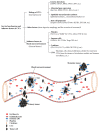Survival Mechanisms and Influence Factors of Circulating Tumor Cells
- PMID: 30515411
- PMCID: PMC6236925
- DOI: 10.1155/2018/6304701
Survival Mechanisms and Influence Factors of Circulating Tumor Cells
Abstract
Circulating tumor cells (CTCs) are cancer cells shed from either the primary tumor or its metastases that circulate in the peripheral blood. The CTCs are regarded as the source of tumor recurrence and metastasis and speculated as the indicators of residual tumors, thereby indicating a poor prognosis. Although CTCs play a vital role in tumor metastasis and recurrence, little is known about the underlying survival mechanisms in the blood circulation. The accumulating evidence has revealed that CTCs might survive in the peripheral blood by overcoming the mechanical damage due to shear stress, resistance to anoikis, evasion of immune destruction, and resistance to chemotherapy. The present review addresses the putative survival mechanisms underlying the formation and migration of CTCs according to their biological characteristics and blood microenvironment. In addition, the relationship between CTCs and microenvironment is illustrated, and the influencing factors related to the interactions of CTCs with various components in the peripheral blood are reviewed with respect to the platelets, immune cells, cytokines, and circulating tumor microemboli (CTM). Furthermore, the recent advances in the new treatment strategies targeting the survival mechanisms of CTCs are also discussed.
Figures

References
Publication types
MeSH terms
Substances
LinkOut - more resources
Full Text Sources

